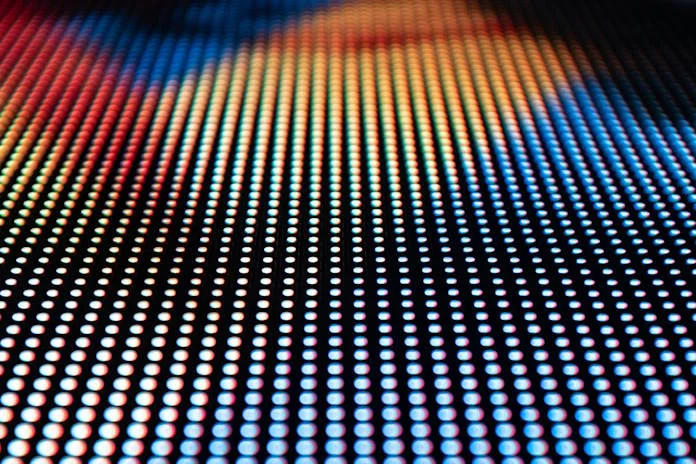When people talk about displays, the conversation often focuses on resolution, with 1080p, 1440p, or 4K being the common options. But resolution on its own doesn’t tell the whole story. A crucial piece of the puzzle is pixel density, usually expressed as pixels per inch (PPI). This measurement describes how tightly packed the pixels are on a display. Two screens may both be 4K, but the one with a smaller physical size will have more pixels squeezed into every inch, creating a sharper, more refined image. For creative professionals including architects, photographers, color graders, 3D product designers, and others, this difference can be transformative. But even people outside of design fields can reap substantial benefits from a high PPI monitor, though they often don’t realize it until they’ve experienced the improvement firsthand.
Through new panel technologies, we’ve been able to kick up the PPI on many of our latest ProArt Displays, and they’re proving to be some of our most popular options in the series. The ROG and TUF Gaming lineups offer models that live the high PPI life, and you’ll find productivity-focused options in the ASUS business monitor family, too. If you haven’t dug into the world of high PPI monitors before, you might have some questions. Here, we’ll dig into the basics, talk about the typical use cases for these monitors, and offer some recommendations for your setup.
PPI matters when you need to work up close
PPI and viewing distance go hand-in-hand. A 65-inch 4K television has a PPI of roughly 67, which isn’t very high, comparatively speaking. If you stick your nose up close, the image will look fuzzy and pixelated. But that doesn’t matter when you’re lounging on your couch across the room watching a movie. From the appropriate viewing distance, the image will be sharp and clear. For contrast, your smartphone is often quite close to your eyes when you’re using it, making PPI one of the most important specs for its screen. PPI values of 500 or more are common with flagship smartphones.
Desktop displays sit somewhere between these two extremes when it comes to PPI, and that’s because of where you sit when you use one. When you’re seated in your office chair, you’ll be up close and personal with your monitor, albeit not quite as close as you get with your smartphone. Desktop monitors come in a wide range of sizes and resolutions, but a PPI in the neighborhood of 100 is typical for standard options.
Is a PPI of 100 good enough? For many of us, that depends on what we’re doing with our PC. If you’re watching videos on YouTube or gaming with a controller, you’re likely to be leaning back in your chair, and a 100 PPI monitor is probably just fine. But many other PC use cases involve leaning in: analyzing data on a spreadsheet, editing raw camera footage in Adobe Lightroom, writing emails, building a 3D model in Blender, and more. For use cases like these, people tend to prefer a monitor with a higher PPI.
High PPI monitors let you fit more on the screen without losing clarity
A key advantage for high PPI monitors comes in the realm of everyday multitasking. Think about what happens when you grab a Microsoft Word window that’s been occupying the entire screen and position it on the right side of the screen instead. That lets you go split-screen with two different apps, perhaps letting you refer to source materials on one side of the display while writing up your document on the other. But this move also cuts in half the number of pixels that Word has available to show your document, typically requiring you to zoom out to see everything, with potentially fuzzier text as a result.
On a monitor with a lower PPI, that might be a deal-breaker. You might lose enough clarity in split-screen mode that you end up using a different multitasking solution. But on high-density displays, content and user interfaces scale without sacrificing clarity. Text will stay clear and comfortably readable even when you’re looking at two windows at once. Icons, menus, and UI elements look clean and proportionate instead of chunky or jagged. High PPI monitors make working with multiple windows side by side feel less cluttered and more legible. Even mundane activities like adjusting spreadsheets, managing email, or organizing photos become smoother experiences.
If you checked out a higher-resolution monitor back in the day when they first came out, you might have noticed odd visual abnormalities when scaling icons, menu bars, and content to an appropriate size for your monitor. Largely, that’s not a factor anymore. You might find an odd app here or there that isn’t built for scaling on a high PPI display, but such screens are so common these days, especially in the laptop space, that you’ll almost certainly have a seamless experience with a high PPI monitor.
High PPI monitors give creators more workspace without demanding more of your desktop
Creators multitask as much as any PC users, if not more so, but even when they’re focused on using one app, they often need a lot of visual workspace. Think about a web designer editing a photo, for instance. Not only do they need the screen real estate to view the picture that they’re working on, but they also need space on the screen for the app interface.
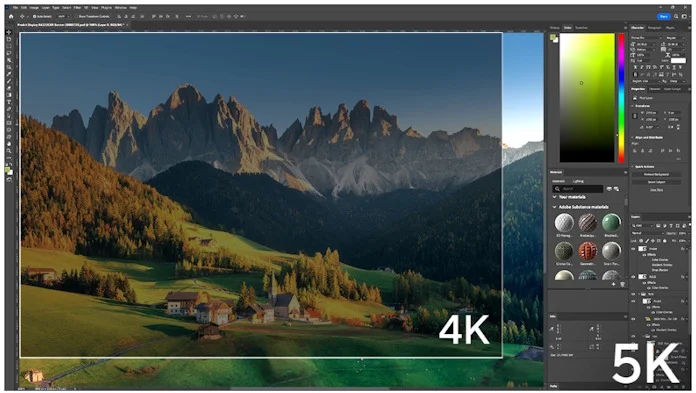
A larger, higher-resolution monitor or a multi-monitor setup could also increase the size of your workspace, but these options aren’t feasible for every PC setup or every creative workflow. A high PPI monitor gives you the advantages of the increased workspace without necessarily increasing the size of your monitor.
High PPI monitors offer better clarity for text and creative projects alike
If your PC use cases involve looking at things with lots of fine lines, you’re quite likely to appreciate the benefits of a high-density display. Let’s say that you’re looking at a wireframe render in Blender. The fine, high-contrast lines in this workspace will make jagged edges or pixel stair-stepping very obvious on a lower-PPI display. Antialiasing techniques can help, but at the cost of a bit of fuzziness. Upgrading to a monitor with increased pixel density is a much better answer. When pixels are smaller and more tightly packed together, it’s harder to perceive the inevitable oddities that come with rendering images using pixels.
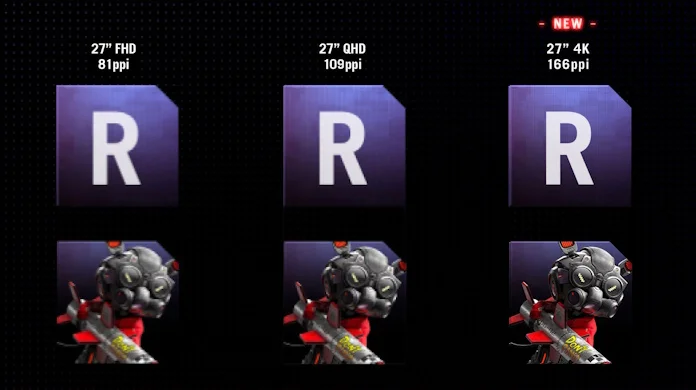
But it’s not just 3D product designers and architects who benefit from visually cleaner, sharper lines. All this applies to text, too. Anyone who spends long hours reading documents, coding, or browsing the web knows the strain that comes from fuzzy text. High PPI monitors make letters crisper, reducing the eye fatigue that often sets in after extended screen sessions. For people whose jobs involve large amounts of reading or writing, a high PPI monitor can make a tangible difference in productivity and comfort, especially after a long workday.
For digital artists, a high PPI monitor pays dividends
Illustrators and digital painters also benefit enormously from the clarity provided by a high PPI monitor. A brush stroke rendered on a monitor with a higher pixel density looks closer to how it would appear in print or in a high-quality digital export. It becomes easier to differentiate between subtle textures, gradients, and line thicknesses.
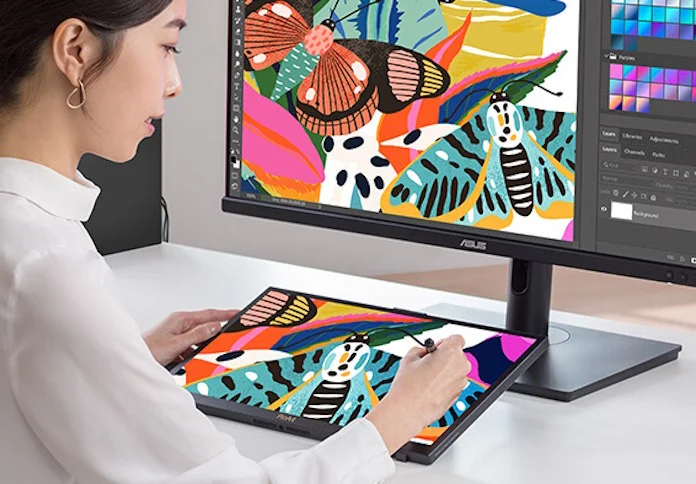
Instead of second-guessing how a mark will translate outside of the software environment, artists can work with a level of trust that what they see is an accurate representation of what they will get. For professionals, this not only saves time but also reduces the number of frustrating surprises during client reviews or final output.
A high PPI monitor can be valuable for gaming, with some caveats
Though it’s not usually the first spec on their monitor shopping checklist, gamers also have a stake in high PPI technology. As with other types of content, games look sharper on a high PPI monitor. Aliasing is less of a concern, removing some of the need for heavy-handed antialiasing techniques. Fine details in textures, environmental design, and character models stand out in ways that lower-density screens can’t replicate. In genres where visual fidelity enhances immersion, such as role-playing games or exploration-heavy titles, the difference is striking.
All else being equal, gamers benefit from elevated PPI as much as anyone. But all else isn’t exactly equal. If you primarily play competitive esports games, for example, you’re probably better off prioritizing a high refresh rate rather than a high PPI. Increased pixel density matters more to fans of cinematic AAA spectacles, but performance can be an obstacle to gaming at high resolutions. As the number of pixels on your display increases, so does the GPU horsepower required for your game to render each frame. Depending on the hardware in your PC, you might find that your games don’t run as well as you’d like on your high PPI monitor.
We should note that this dynamic is changing. Let’s say that you’re looking at 27-inch gaming monitor options, trying to decide between a 1440p model with a 108 PPI or a 4K option with a 166 PPI. Don’t dismiss the 4K option out of hand. It’s very possible that your graphics card is up to the challenge of playing at 4K. The hardware necessary to run games at 4K has been getting increasingly mainstream in recent years, especially when you factor in upscaling technology like DLSS and FSR.
How about monitors with an even higher PPI? As we’ll discuss below, we do offer a 32-inch 8K ProArt monitor with a jaw-dropping 275 PPI. But given the massive performance hit that comes with gaming at 8K, even with top-of-the-line hardware, it’s hard to recommend this monitor for gaming.
Which users should consider a high PPI monitor?
With all this in mind, we can offer some straightforward recommendations for which folks should consider a high PPI monitor for their PC setup.
You should consider a high PPI monitor if you:
- Tend to sit close to your monitor so that you can scrutinize the fine details of your current project
- Routinely multitask with two or more visible windows on one monitor
- Spend a considerable portion of your workday reading text on your monitor
- Use content creation apps for video editing, CAD, digital art, or other profession pursuits
- Typically play immersive games with lifelike visuals using a PC with a powerful GPU
You should consider a standard-PPI monitor if you:
- Tend to use only one application at a time when you use your PC
- Use your PC primarily for entertainment, like online streaming
- Typically play competitive esports games
ProArt leads the way with feature-rich high PPI monitors for creators
Pixels-per-inch is far from the only display spec that’s vital for creators. Professional-grade color accuracy matters, too, and your workflows might call for specialized I/O options, support for multiple HDR metadata formats, a built-in colorimeter, and more. The ProArt Display family supports your creative ambitions with options ranging from wallet-friendly monitors for college students to feature-rich displays designed for professionals in diverse fields.
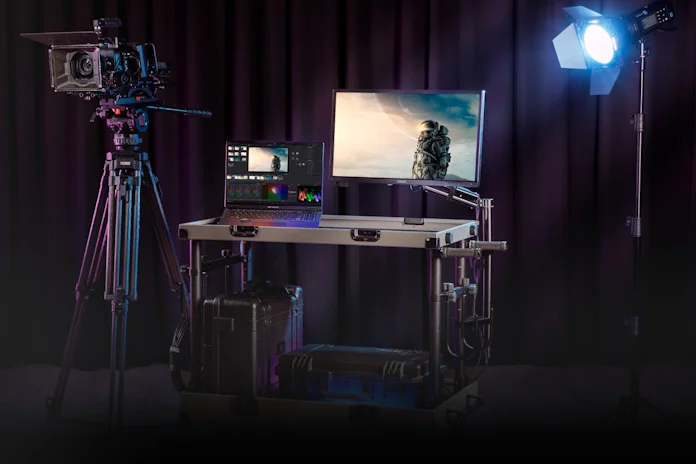
If you need a high PPI monitor for your creative work, we offer a variety of options in several sizes. Starting with the smallest, the ProArt Display PA24US packs a 3840×2160 resolution in a 24-inch frame (23.6-inch viewable), yielding an excellent 187 PPI. Its relatively compact size readies it for life on a studio production cart, as does its port selection. This monitor includes a 12G-SDI connector. Through this input, the PA24US can receive uncompressed video footage up to 4K@60Hz directly from camera devices with ultra-low latency. And since 12G-SDI has a locking mechanism and allows for extremely long cables, it’s often a must-have feature for an on-set monitor.
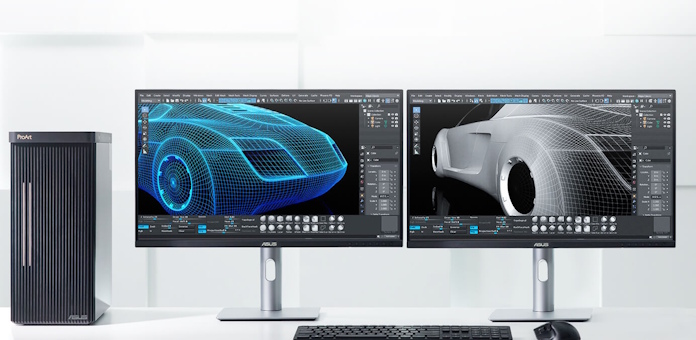
The ProArt Display 5K PA27JCV might be the all-around workhorse of the group. As a 27-inch display, it’s an easy fit on almost any creator’s desk, even in a multi-monitor configuration. It ups the ante with a 5K resolution, which works out to a 218 PPI. The bolstered resolution gives you 77% more workspace than a 4K monitor of the same size. For comfortable, color-accurate viewing, it also features our new LuxPixel™ technology. This anti-glare, low-reflection (AGLR) coating provides a paper-like screen effect to minimize reflections, ensuring accurate colors and sharp details.
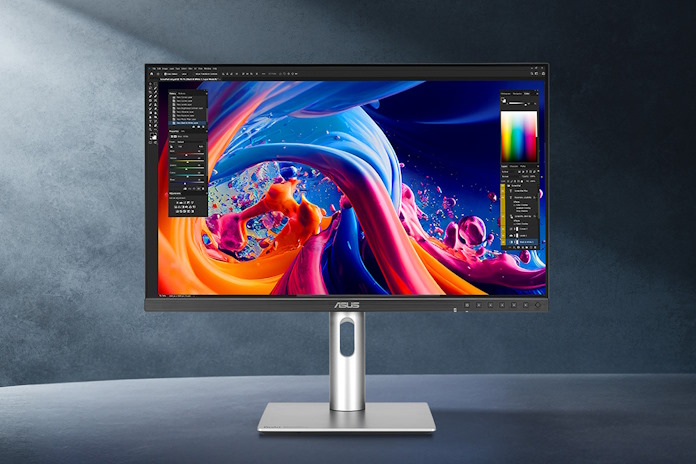
Perhaps you like the PPI of the ProArt Display 5K PA27JCV, but you’d prefer it on an even larger display. The ProArt Display 6K PA32QCV was built for you. Boasting a 6016×3384 resolution on a 32-inch panel, this monitor offers the same ultra-sharp 218 PPI as its 27-inch cousin. Monitor options that pair such a high PPI with a large 32-inch diagonal are quite rare. On top of premium pixel density, this display also offers rich connectivity including two Thunderbolt™ 4 ports, a LuxPixel™ AGLR coating, exceptional color gamut coverage, and more.
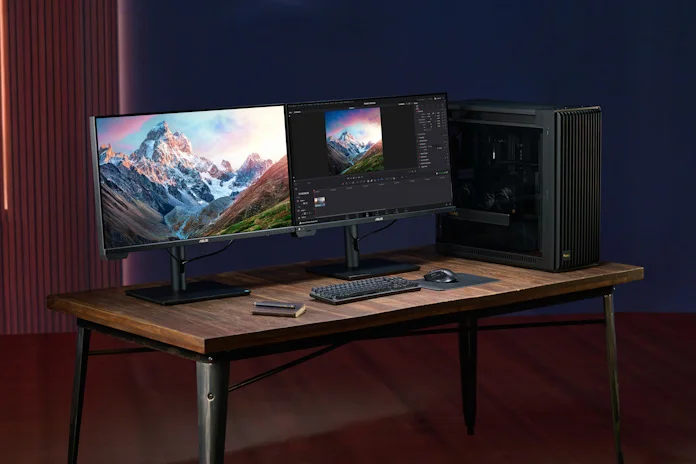
Finally, an even-higher PPI option that’s on the way soon: the ProArt Display 8K PA32KCX. It’s the same 32-inch size as the 6K option, but kicks the resolution all the way up to 7680×4320 for a superb 275 PPI. There’s more to talk about with this flagship monitor than we have space for here, but it’s a standout in every respect. It uses a mini-LED backlight with 4032 local dimming zones to deliver exceptional HDR performance: up to 1200 nits peak brightness, and up to 1000 nits sustained brightness without partial patch limitation. It offers an average ΔE value of less than one for world-leading color accuracy, and it covers 97% of the cinema-grade DCI-P3 color gamut for beautifully saturated color reproduction. ASUS ProArt Hardware Calibration technology provides color-accuracy optimization and color profile write-back.
It’s worth noting that the lofty resolutions of both the PA32KCX and the PA32QCV make them compelling choices for creators working with high-resolution assets. 6K and 8K cameras are relatively common in creative fields, yet reference monitors with comparably high resolutions aren’t. These displays will let you analyze high-res footage without downscaling, all while elevating your workflow with their creator-focused feature sets.
| High-PPI ProArt Displays | ||||
|---|---|---|---|---|
| Model | Size | Resolution | PPI | US |
| ProArt Display PA24US | 24" | 4K | 187 | ASUS |
| ProArt Display 5K PA27JCV | 27" | 5K | 218 | ASUS Amazon Best Buy B&H |
| ProArt Display 6K PA32QCV | 32" | 6K | 218 | ASUS |
| ProArt Display 8K PA32KCX | 32" | 8K | 275 | |
Boost your gaming setup with a high PPI monitor
If you’re a gamer who’s on the hunt for a high PPI monitor, we recommend looking for a 27-inch option that pairs a 4K resolution with an elevated refresh rate. For our first recommendation, we’ll cheat just a little bit on those requirements with the TUF Gaming VG28UQL1A. It’s actually a 28-inch model, giving it a slightly lower 157 PPI, but that’s still head and shoulders over what you’ll get with a similarly sized 1440p monitor. Its 144Hz refresh rate will keep the on-screen action smooth, and it includes NVIDIA G-SYNC Compatibility, AMD FreeSync, Variable Overdrive, and a 1ms (GTG) response time for clear, tear-free gaming at low latency.
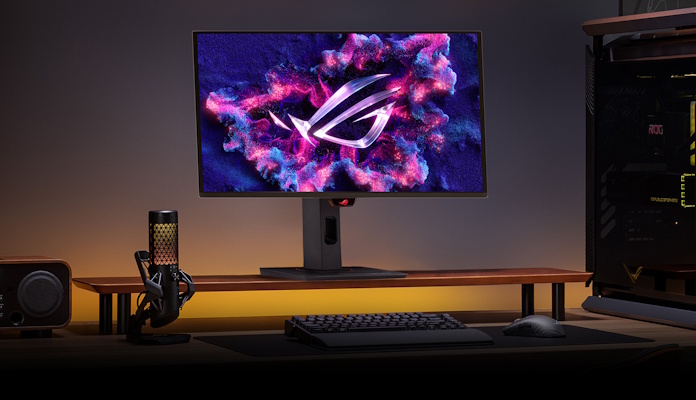
Perhaps you prefer the lavish colors and riveting contrast of an OLED panel. Bump up to the ROG Strix OLED XG27UCDMG, and you’ll get a premium 4th-gen QD-OLED panel, a lofty 240Hz refresh rate, and an ultra-low 0.03ms response time. The latest ROG refinements give you the best experience with your OLED monitor, including ROG OLED Anti-Flicker 2.0, OLED Care Pro, and a Neo Proximity Sensor that transitions the screen to a black image when you step away from your PC in order to protect it against panel burn-in.
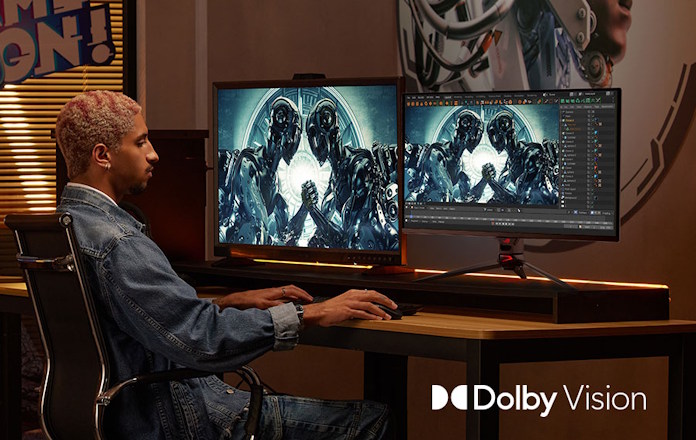
If future-proofed connectivity is high on your gaming monitor shopping checklist, you might be best off with the ROG Swift OLED PG27UCDM. As the most premium high PPI option in the ROG OLED monitor selection, the PG27UCDM includes everything that its little cousin offers but adds a DisplayPort 2.1a port to the mix. This port is capable of up to 80Gbps of throughput thanks to the four lanes of the UHBR20 link, allowing it to drive 4K 240Hz without compression.
The ROG Swift OLED PG27UCDM might also attract your attention if you work in a creative field that calls for a high refresh rate. Creators who work with static media typically do just fine with a 60Hz monitor, but fields like game development call for monitors that balance professional-grade specs with gaming-centric features.
| High-PPI ASUS Gaming Displays | ||||
|---|---|---|---|---|
| Model | Refresh Rate | Resolution | PPI | US |
| TUF Gaming VG28UQL1A | 144Hz | 4K | 157 | ASUS Amazon B&H |
| ROG Strix OLED XG27UCDMG | 240Hz | 4K | 166 | ASUS Newegg Best Buy |
| ROG Swift OLED PG27UCDM | 240Hz | 4K | 166 | ASUS Newegg Amazon Best Buy Micro Center |
A high PPI monitor for everyday computing and productivity
Perhaps you’re convinced that you’d enjoy the benefits of a high PPI monitor, but you’re neither a creator nor a gamer, and you’d rather not invest in display features that you won’t use. You’ll find the value that you’re looking for in our business monitor lineup.
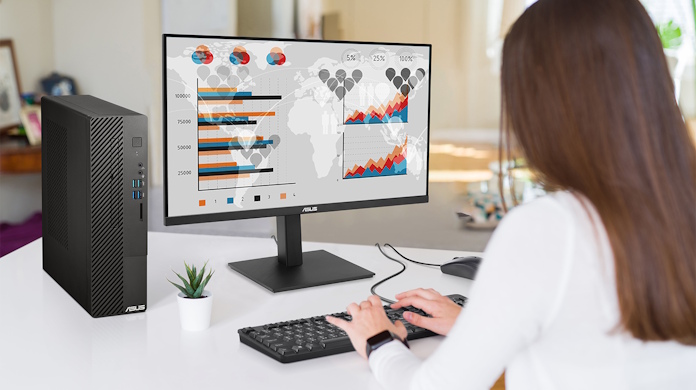
The ASUS VA27UQSB is easy to recommend for folks who need a high PPI monitor that delivers on all the essentials. This 27-inch 4K monitor is easy to fit on just about any desk, especially with its compact yet sturdy stand design. Tilt, swivel, pivot, and height adjustments let you position it at the perfect ergonomic angle, and you can rotate it a full 90° to take advantage of portrait orientation. Narrow display bezels make it a great choice for multi-monitor display setups. For comfortable all-day use, it offers TÜV Rheinland-certified Flicker-free and Low Blue Light technologies, too.
The ASUS VA27UCPS offers the same PPI as the VA27UQSB, but it also has a trick up its sleeve that streamlines life for laptop users. It includes a USB Type-C port capable of not only accepting a display signal but connecting peripherals to the USB Hub and recharging a connected device with 65W USB Power Delivery. That means that connecting your full PC setup at your desk will be as easy as plugging in a single cable to your laptop.
| High-PPI ASUS Displays | ||||
|---|---|---|---|---|
| Model | Size | Resolution | PPI | US |
| ASUS VA27UQSB | 27" | 4K | 166 | ASUS Amazon B&H |
| ASUS VA27UCPS | 27" | 4K | 166 | ASUS Amazon |
Treat your eyes with a high PPI ASUS monitor
Ultimately, what high PPI monitors offer is a shift in how we experience digital content. For creative professionals, they’re essential tools that enable efficiency, clarity, and comfort. For everyone else, they quietly elevate the everyday, making text easier to read, images more enjoyable to view, and digital environments more comfortable to inhabit.
In the end, whether you’re a designer fine-tuning a project, a gamer diving into a richly detailed world, or simply someone who spends their day writing emails and browsing the web, a high PPI monitor has something to offer. Creative industries may have been the first to recognize the value of high pixel density, but the truth is that everyone benefits from a sharper, clearer view of digital worlds.
Top image credit: Photo by Bernard Hermant on Unsplash

